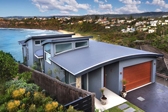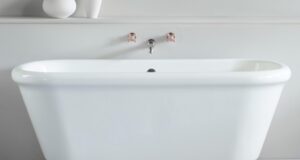
Steel is the most popular roofing material in Australia. As well as being very durable, it’s also lightweight, requires little maintenance and can be used for many different roof styles.

Image courtesy of Colorbond.
What are steel roofs?
While metal roofs are also available using other materials (including tin), the vast majority of metal roofs that are installed these days are steel roofs. This is mainly due to steel’s cost, durability, longevity and strength, all of which make it a very versatile roofing material.
Steel used for modern roofs is normally treated and coated with a number of different finishes to improve its performance as a roofing material. This includes alloy coatings to help corrosion resistance, and special polyester coatings that protect the steel and help to retain its colour.
Metal roofs in Australia tend to be installed in large, corrugated sheets or panels rather than using smaller tiles (although metal roofing tiles are available). These metal sheets are available from different suppliers who produce metal roofing sheets in a range of different corrugation or pattern styles (or ‘profiles’).
Properties of steel roofs
Metal roofs have a number of appealing features, including their durability, climatic suitability, and a versatile appearance:
Durability
Some steel roofing companies guarantee their roofs against corrosion for up to 30 years, and other companies provide 50 year warranties. The coatings that are applied to modern steel roofing generally do a very good job of protecting it from corrosion and the elements, and provided that they’re cut and installed properly, under normal conditions today’s metal roofs are far more durable than the corrugated tin and corrugated iron roofs that were used in the past.
Climatic suitability and insulation
Steel roofs are ideal for the extremes of the Australian climate. They are resistant to fire, rarely suffer damage from hail, and provided that they’re installed correctly, they have a good chance of remaining fixed in the face of strong winds and cyclones.
Certain steel roofs are also treated in a way that allows them to absorb less and reflect more heat from the sun, which helps to significantly reduce the amount of heat that’s allowed to radiate into your home during summer. These roofs are normally also painted in a lighter colour to further improve their cooling properties.
Because they’re made of thin sheeting, steel roofs don’t provide much in the way of thermal mass, and while other materials may absorb heat during the day and release it at night, metal roofs aren’t suitable for this type of thermal regulation.
Depending on how well they’re designed and insulated, houses with steel roofs may cost more to heat during the colder months than houses with other materials. They may also offer less in the way of soundproofing than other types of roofs, depending on how they’re insulated. Steel roofs are installed with foil between roofing sheets for insulation, or foil-and-blanket insulation to also help reduce noise when it rains.
Appearance
Metal roofs are very versatile as far as shape and colour are concerned. The shape of a metal roof can be either fairly conservative and traditional (for example, gabled or hip roofs), or can be bent to look more modern, fluid and organic (e.g. curved roofs). There are also many different options available in terms colour, style of corrugation – or even tiles.
Weight and load bearing capacity
Metal sheeting is a relatively lightweight building material, and as such it places less of a load on the building structure than many other roofing materials might. It’s also strong, and can normally bear the weight of things like thermosiphon hot water systems and solar panels without fear of damage.
Where are steel roofs used?
Because they can be treated, coloured and shaped to offer a variety of different thermal properties and styles, steel roofs are used in all sorts of houses and climates throughout Australia.
Metal roofs offer good resistance to fire, and metal is also often used for structures in alpine areas. The smooth surface helps snow to slide off roofs, while the relatively light weight of steel increases the amount of snow that can be built up before the load bearing ability of the walls is compromised.
|
Advantages
|
Disadvantages
|





